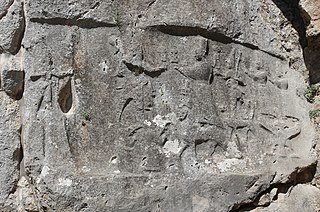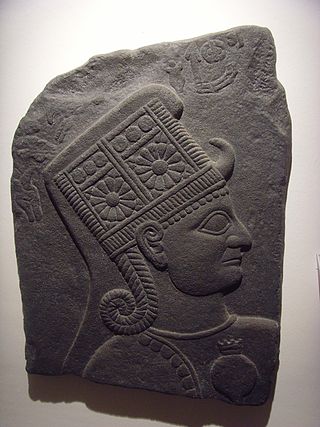Hittitology is the study of the Hittites, an ancient Anatolian people that established an empire around Hattusa in the 2nd millennium BCE. It combines aspects of the archaeology, history, philology, and art history of the Hittite civilisation. There are two universities in Turkey with a Hittitology major studies besides some minors and chairs, one of Istanbul University and Ankara University.
A minor programme in Hittitology (B.A.) has recently been created at Philipps-Marburg University, Germany. [1]
A partial list of notable Hittite scholars includes:

Ninḫursaĝ, sometimes transcribed Ninursag, Ninḫarsag, or Ninḫursaĝa, also known as Damgalnuna or Ninmah, was the ancient Sumerian mother goddess of the mountains, and one of the seven great deities of Sumer. She is known earliest as a nurturing or fertility goddess. Temple hymn sources identify her as the "true and great lady of heaven" and kings of Lagash were "nourished by Ninhursag's milk". She is the tutelary deity to several Sumerian leaders.
The Anatolian languages are an extinct branch of Indo-European languages that were spoken in Anatolia. The best known Anatolian language is Hittite, which is considered the earliest-attested Indo-European language.

Teshub was the Hurrian weather god, as well as the head of the Hurrian pantheon. The etymology of his name is uncertain, though it is agreed it can be classified as linguistically Hurrian. Both phonetic and logographic writings are attested. As a deity associated with the weather, Teshub could be portrayed both as destructive and protective. Individual weather phenomena, including winds, lightning, thunder and rain, could be described as his weapons. He was also believed to enable the growth of vegetation and create rivers and springs. His high position in Hurrian religion reflected the widespread importance of weather gods in northern Mesopotamia and nearby areas, where in contrast with the south agriculture relied primarily on rainfall rather than irrigation. It was believed that his authority extended to both mortal and other gods, both on earth and in heaven. However, the sea and the underworld were not under his control. Depictions of Teshub are rare, though it is agreed he was typically portrayed as an armed, bearded figure, sometimes holding a bundle of lightning. One such example is known from Yazılıkaya. In some cases, he was depicted driving in a chariot drawn by two sacred bulls.
Kumarbi, also known as Kumurwe, Kumarwi and Kumarma, was a Hurrian god. He held a senior position in the Hurrian pantheon, and was described as the "father of gods". He was portrayed as an old, deposed king of the gods, though this most likely did not reflect factual loss of the position of the head of the pantheon in Hurrian religion, but only a mythological narrative. It is often assumed that he was an agricultural deity, though this view is not universally accepted and the evidence is limited. He was also associated with prosperity. It was believed that he resided in the underworld.

Kušuḫ, also known under the name Umbu, was the god of the moon in Hurrian pantheon. He is attested in cuneiform texts from many sites, from Hattusa in modern Turkey, through Ugarit, Alalakh, Mari and other locations in Syria, to Nuzi, located near modern Kirkuk in Iraq, but known sources do not indicate that he was associated with a single city. His name might be derived from the toponym Kuzina, possibly the Hurrian name of Harran, a city in Upper Mesopotamia, but both this etymology and identification of this sparsely attested place name remain uncertain. He was a popular, commonly worshiped god, and many theophoric names invoking him are known. In addition to serving as a divine representation of the moon, he was also associated with oaths, oracles and pregnancy. Some aspects of his character were likely influenced by his Mesopotamian counterpart Sin, while he in turn was an influence on the Ugaritic god Yarikh and Luwian Arma.
Hayasa-Azzi or Azzi-Hayasa was a Late Bronze Age confederation in the Armenian Highlands and/or Pontic region of Asia Minor. The Hayasa-Azzi confederation was in conflict with the Hittite Empire in the 14th century BC, leading up to the collapse of Hatti around 1190 BC. It has long been thought that Hayasa-Azzi may have played a significant role in the ethnogenesis of Armenians.
Cornell Fleischer was an American historian and the Kanuni Suleyman Professor of Ottoman and Modern Turkish Studies at the University of Chicago.

Šauška (Shaushka), also called Šauša or Šawuška, was the highest ranked goddess in the Hurrian pantheon. She was associated with love and war, as well as with incantations and by extension with healing. While she was usually referred to as a goddess and with feminine titles, such as allai, references to masculine Šauška are also known. The Hurrians associated her with Nineveh, but she was also worshiped in many other centers associated with this culture, from Anatolian cities in Kizzuwatna, through Alalakh and Ugarit in Syria, to Nuzi and Ulamme in northeastern Mesopotamia. She was also worshiped in southern Mesopotamia, where she was introduced alongside a number of other foreign deities in the Ur III period. In this area, she came to be associated with Ishtar. At a later point in time, growing Hurrian influence on Hittite culture resulted in the adoption of Šauška into the Hittite state pantheon.

Metropolis is a classical city situated in western Turkey near Yeniköy village in Torbali municipality - approximately 40 km SE of İzmir. Occupation at the site Bademgediği Tepe goes back to the Neolithic period. In the Late Bronze Age, the city was known under the Hittites as Puranda. Classical, Hellenistic, Roman, Byzantine, and Ottoman periods are well represented at the site.

Mehmet Hakkı Suçin is an author, literary translator and Arabist from Turkey.

The Hurrian religion was the polytheistic religion of the Hurrians, a Bronze Age people of the Near East who chiefly inhabited the north of the Fertile Crescent. While the oldest evidence goes back to the third millennium BCE, it is best attested in cuneiform sources from the second millennium BCE written not only in the Hurrian language, but also Akkadian, Hittite and Ugaritic. It was shaped by contacts between the Hurrians and the various cultures with which they coexisted. As a result, the Hurrian pantheon included both natively Hurrian deities and those of foreign origin, adopted from Mesopotamian, Syrian, Anatolian and Elamite beliefs. The culture of the Hurrians was not entirely homogeneous, and different local religious traditions are documented in sources from Hurrian kingdoms such as Arrapha, Kizzuwatna and Mitanni, as well as from cities with sizeable Hurrian populations, such as Ugarit and Alalakh.

Tarḫunna or Tarḫuna/i was the Hittite weather god. He was also referred to as the "Weather god of Heaven" or the "Lord of the Land of Hatti".

Ali Maximilian Ertürk is a neuroscientist, inventor, and artist living in Munich, Germany. He is the director of a new Helmholtz Institute on Tissue Engineering and Regenerative Medicine (iTERM) in Munich since July 2019 and professor at the medical faculty. After his undergraduate study at Bilkent University in Ankara, he joined Max-Planck-Institute for Neurobiology for his PhD and Genentech Inc. for postdoctoral research.

Kubaba was a goddess of uncertain origin worshiped in ancient Syria. Despite the similarity of her name to these of legendary queen Kubaba of Kish and Phrygian Cybele, she is considered a distinct figure from them both. Her character is poorly known. Multiple local traditions associating her with other deities existed, and they cannot necessarily be harmonized with each other. She is first documented in texts from Kanesh and Alalakh, though her main cult center was Carchemish. She was among the deities worshiped in northern Syria who were incorporated into Hurrian religion, and in Hurrian context she occurs in some of the Ugaritic texts. She was also incorporated into Hittite religion through Hurrian intermediaties. In the first millennium BCE she was worshiped by Luwians, Arameans and Lydians, and references to her can be found in a number of Greek texts.
Turkish–Islamic synthesis is a type of Turkish nationalism which has an Islamist leaning instead of secular.
Iyarri, also known as Yarri, was a god worshiped by Hittites and Luwians in Anatolia in the Bronze Age. He was associated with plague and war, and was portrayed as an archer whose arrows inflicted people with illnesses. While it is generally assumed that Iyarri was male, a female form of this deity is mentioned in a single text. It has been proposed that Iyarri might have developed from the Mesopotamian god Erra, or that he was influenced by him. A different proposal considers his name a cognate of that of Greek Ares, though the evidence in favor of this view is not conclusive.
Iyaya was a Hittite and Luwian goddess. Her functions remain uncertain, though it has been suggested she was associated with water or more broadly with nature. She might have been associated with the god Šanta, though the available evidence is limited. Her main cult centers were Lapana and Tiura, though she was also worshiped in other cities.
Pišaišapḫi was a Hurrian mountain god. His name was derived from that of the associated mountain, Pišaiša, which was most likely located next the Mediterranean coast. He is attested in Hurrian and Hittite ritual texts from cities such as Hattusa, Šapinuwa and Ugarit. A Hittite literary text known as Myth of Pišaiša is focused on him, though its origin and the reading of the names of other deities who play roles in it remains a matter of debate among researchers.